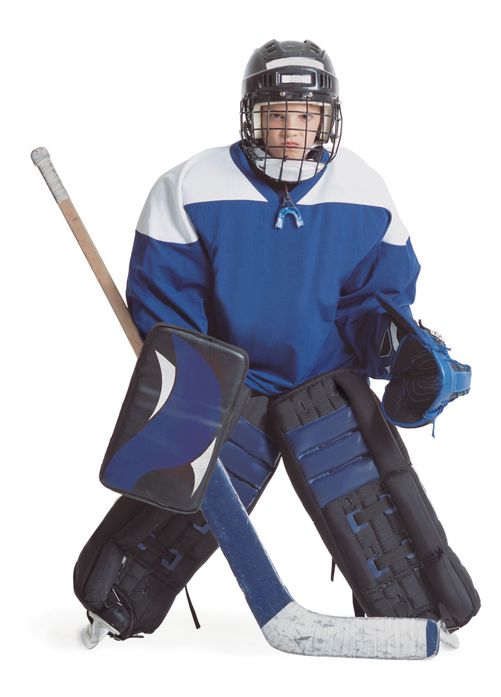Staying Healthy
Hockey Injury Prevention
Ice hockey is one of the fastest growing organized sports in the United States. USA Hockey, the nation's governing body for the sport, states that a record number of children have played hockey through its organization in recent years. Both boys and girls play ice hockey, with opportunities for girls increasing every year.
Contact and non-contact injuries are common in hockey players of all ages and skill levels. This article discusses common hockey injuries and strategies to help prevent them.
Team Play
Youth hockey is usually divided into two types of teams: in-house and travel.
- The in-house program is often sponsored by the home ice rink and is designed for teaching fundamental skills. These generally include puck handling, game rules, power skating techniques, and basic plays.
- More advanced players typically move on to travel teams. These teams will travel to other towns to play other travel teams. The play of these teams is usually more advanced.
Common Hockey Injuries
Because of the contact nature of ice hockey, it is considered a collision sport. Injuries occur from contact with other players, the stick, the puck, and the boards. These are some common contact injuries:
- Sprained ankles and knee ligament tears
- An overstretched medial collateral ligament at the inside of the knee, from a blow to the outside of the knee
- A wrist fracture or shoulder dislocation, from a fall on the ice or collision with another player
- Concussions
- Broken teeth
- Spine or spinal cord injuries
Non-contact injuries may occur from overuse, such as:
- Lower back strains, caused by the frequent forward bending required during skating
- Muscle pulls, especially of the hamstring and groin, caused by muscle overload during a forceful push into a skating sprint
- Hip impingement and labral injuries in goalies, due to hip positioning while blocking shots
Several strategies can help prevent hockey injuries — from preparation and safety equipment to skill development and rule enforcement.
Ensure Proper Equipment
Ice hockey requires a lot of protective equipment, and it must fit properly to effectively protect the player. The necessary equipment includes:
- Helmet
- Mouth guard (either custom-made or "boil and bite" off the shelf)
- Face shield
- Shoulder pads
- Elbow pads
- Gloves
- Jersey
- Pants (girdle and shell)
- Cup/supporter
- Shin guards
- Skates
- Stick
Goalies require additional equipment:
- Leg pads
- Catch glove
- Blocker
- Chest and arm protector
- Helmet with face mask
- Goalie skates
- Goalie stick
Hockey equipment can be expensive. Good used equipment can often be found, but make sure it fits appropriately and is not damaged.
Proper Preparation for Play
Before taking to the ice to play hockey, participants must have mastered basic skating skills, such as skating forward and backward. Most ice rinks offer pre-hockey skating classes to teach skating fundamentals. These classes are available at all age levels.
Tips for proper preparation at the team play level include:
- Maintain fitness. Be sure you are in good physical condition at the start of hockey season. During the off-season, stick to a balanced fitness program that incorporates aerobic exercise, strength training, and flexibility. If you are out of shape at the start of the season, gradually increase your activity level and slowly build back up to a higher fitness level.
- Warm up and stretch. Always take time to warm up and stretch, especially your shoulders, hips, knees, thighs, and calves. Research studies have shown that cold muscles are more prone to injury. Warm up off the ice with jumping jacks, stationary cycling, or running or walking in place for 3 to 5 minutes. On the ice, skate at a lower intensity for 3 to 5 minutes. Dynamic stretches, such as arm circles, leg swings, and torso twists can also help prepare your body for activity.
- Cool down and stretch. Stretching at the end of practice is often neglected because of busy schedules. Stretching can help reduce muscle soreness and keep muscles long and flexible. Slowly and gently stretch after activity, holding each stretch for 30 seconds.
- Hydrate. Even mild levels of dehydration can hurt athletic performance. If you have not had enough fluids, your body will not be able to effectively cool itself through sweat and evaporation. A general recommendation is to drink 24 ounces of non-caffeinated fluid 2 hours before exercise. Drinking an additional 8 ounces of water or sports drink right before exercise is also helpful. While you are exercising, break for an 8-ounce cup of water every 20 minutes.
Prepare for Injuries
- Coaches should be knowledgeable about first aid and be able to administer it for minor injuries, such as facial cuts, bruises, or minor strains and sprains.
- Be prepared for emergencies. All coaches should have a plan to reach medical personnel for help with more significant injuries such as concussions, dislocations, contusions, sprains, abrasions, and fractures.
Safe Return to Play
An injured player's symptoms must be completely gone before returning to play. For example:
- In case of a joint problem, the player must have no pain, no swelling, full range of motion, and normal strength.
- In case of concussion, the player must have no symptoms at rest or with exercise, and should be cleared by the appropriate physician or medical provider.
Prevent Overuse Injuries
Because many young athletes are focusing on just one sport and are training year-round, doctors are seeing an increase in overuse injuries. The American Academy of Orthopaedic Surgeons has partnered with STOP Sports Injuries to help educate parents, coaches, and athletes about how to prevent overuse injuries. Specific tips to prevent overuse injuries include:
- Limit the number of teams on which your child is playing in one season. Kids who play on more than one team are especially at risk for overuse injuries.
- Do not allow your child to play one sport year round — taking regular breaks and playing other sports is essential for both skill development and injury prevention.
Additional Guidelines
In an effort to reduce hockey injuries, researchers have conducted studies to better understand the risks of play. Rule changes and better enforcement of existing rules, along with improved protective equipment, are some of the outcomes of this research. In addition, educating coaches and officials about injury risks has become a priority. Potentially dangerous actions, such as checking from behind and using the stick or helmet as a weapon, have been eliminated from the game.
Coaches, athletes, and parents must be aware of the possible injuries and follow the rules in place to prevent them. Serious injuries can be prevented if players avoid dangerous tactics or overly aggressive play.
For more information on ice hockey, go to USA Hockey, Inc. Founded in 1936-37, USA Hockey is the national governing body for the sport in the United States. Its mission is to promote the growth of hockey in America, and provide the best possible experience for all participants by encouraging, developing, advancing, and administrating the sport.
Contributed and/or Updated by
Peer-Reviewed by
AAOS does not endorse any treatments, procedures, products, or physicians referenced herein. This information is provided as an educational service and is not intended to serve as medical advice. Anyone seeking specific orthopaedic advice or assistance should consult his or her orthopaedic surgeon, or locate one in your area through the AAOS Find an Orthopaedist program on this website.








